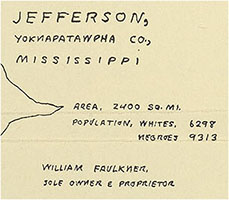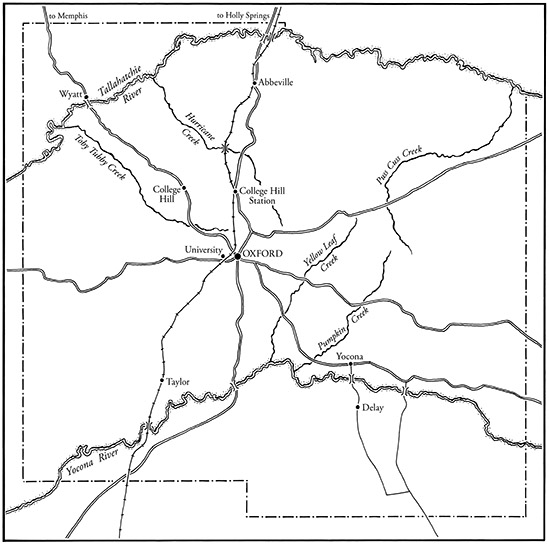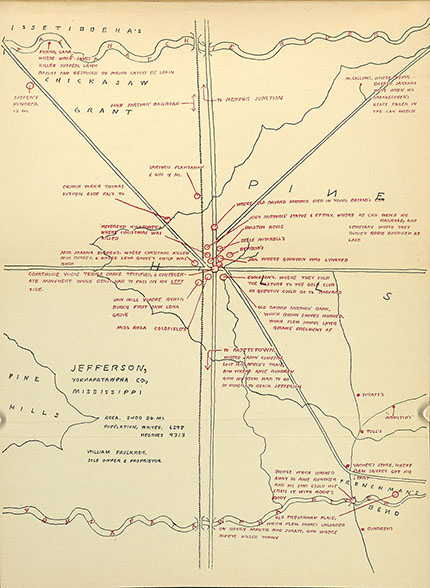|
It's easy to see how closely Yoknapatawpha resembles Lafayette. The two county seats – Oxford and Jefferson – sit near the center, beside the railroads that bisect each county vertically and in the middle of the major roads that lead from town in every direction except southwest. On his map Faulkner claims that his county contains 2400 square miles, which would make it four times larger than Lafayette, but that claim is belied by the distances he repeatedly provides in his fictions, where Sutpen's Hundred is 12 miles northwest of Jefferson, the MacCallum/McCaslin properties 14-15 miles northeast, and Frenchman's Bend 12-20 miles southeast. Using these figures, Yoknapatawpha is nearly the same size as Lafayette (i.e. 679 square miles). In both counties, the richest farm land and most of the large cotton plantations are north of town, while the hill country to the east and south is poorer and, in part as a result of the absence of plantations, whiter. According to Faulkner's map, 15,611 people live in Yoknapatawpha in 1936, which is slightly fewer than Lafayette's 19,978 (1930 census) or 21,257 (1940 census). But Faulkner flips the racial proportions: his county is 60% black, while in the 1930s Lafayette was 60% white. The other major respect in which Yoknapatawpha is different from Lafayette is that Faulkner leaves out the University of Mississippi, which in reality has been on the western edge of Oxford since the 1840s.
Mapping the Terrain of Faulkner's Imagination
One of the great challenges we face in trying to represent Faulkner's world digitally is his love of polyphony, ambiguity and indeterminacy. For example, "Race" is a field in our Character database, where it is divided into ten different categories. But none of them seem adequate to the way Faulkner uses Joe Christmas to enact race as both an existential challenge and an ideological performance. What race does Christmas belong to? Faulkner's narratives are repeatedly organized around such unanswerable questions. Who is Caddy Compson – the sister Benjy loves or the one Jason hates? Who was Thomas Sutpen, and what is the past he epitomizes, the past which may never be dead but which remains elusive, perhaps unknowable? Faulkner is one of the modern writers who transformed the novel in order to represent what Henry Adams, looking for fixed truths, ruefully summed up as "twentieth century multiplicity." Pamela Dalziel locates Faulkner's 1936 map in the context of this project. In her reading, the map's creator is yet another of Absalom's story-tellers, whose visual representation of Sutpen adds yet another interpretive layer to the accounts of Rosa or Mr. Compson or Quentin and Shreve, requiring the reader to entertain yet another way of "looking at a blackbird." The discrepancies between Faulkner's maps and his texts, or between the two maps themselves, could be similarly viewed.
But throughout Faulkner's work the reality of chaos and indeterminacy (or the chaos of reality) competes with the need, perhaps as much psychic as artistic, for order and precision, for putting each thing (to quote the last four words of The Sound and the Fury) "in its ordered place." Light in August brilliantly juxtaposes Joe Christmas' and his southern culture's rage for racial certainty against the narrative's refusal to define his "true" identity, yet when McEachern attends church in Chapter VII of the novel, Faulkner measures the exact distance he travels – three different times. In the manuscript the distance is "8 miles," but when he typed the book he recalibrated it as "five miles," before changing it again in a hand-written revision to "three." Since the reader stays home with Joe and Mrs. McEachern, this fussiness seems over-determined. Faulkner's manuscripts and texts contain many such recalibrations and specific details. Like all forms of art, maps provide a way to impose order on the world, to step outside the welter of experience and apprehend it, to look at life – like an airplane pilot, which Faulkner also was – from a higher and wider perspective.
Four other Faulkner maps in the collections at Southeast Missouri State and Virginia show his quest for order in the context of his own life. Below left: The river at the bottom of this schematic map is the Thames rather than the Yoknapatawpha. Twice during the years after he won the Nobel Prize, Faulkner stayed at Brown's Hotel in London's Mayfair district, first in 1950 on his journey home from Stockholm, and again in 1952, on his way to Paris. The folds in the paper suggest Faulkner may have carried this with him on one of these trips, to make sure he could find his way to the hotel – just as the numbers at the top of the page helped him navigate the unfamiliar British currency. Below right: Several times in the early 1950s Faulkner visited Princeton, New Jersey, as the guest of Saxe Commins, his editor at Random House; on these trips he stayed at both Commins' house and at The Princeton Inn. The few details on this map – "Library Place" and "O [or C?] CiR.," which may be Cambelton Circle – make it likely that it shows the route between the Princeton University train stop (bottom of page) and the Commins' house on Elm Street (top of page). Faulkner may have drawn it for Joan Williams, with whom he was having an affair and who is known to have visited him in Princeton in 1952, though the paucity of labels may mean Faulkner drew it for himself. In either case, like the London map, it was intended to guard against getting lost in an unfamiliar world.
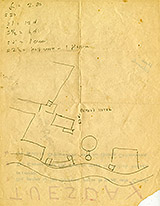 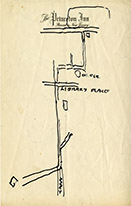
In the Faulkner Foundation collection guide, the two Faulkner maps below are identified as "maps of Lafayette County, intended as frontispiece" for the 1939 novel The Wild Palms; as Thomas McHaney was the first to point out, however, they are two slightly different versions "of a small section of the Mississippi Delta" in Sharkey and Yazoo counties. This is where, during the 1940s and 50s, Faulkner regularly went on the kind of hunting trip he describes in both "Delta Autumn" and "Race at Morning." Gabriele Gutting points out how closely Faulkner's maps follow the Mississippi state map of the Sunflower Wildlife Management Area, including the way Faulkner divides the region into those township quadrangles and uses cross-hatching to identify the areas that are privately owned, and so off-limits to hunters. The red dots, including the ones near the center of both maps labeled "Oxford" (which presumably explains how the maps were misidentified), locate the camps of the different hunting parties that are scattered around the woods. The odds are that Faulkner drew these meticulously organized maps – note how he corrects some grid numbers on the righthand map – to equip himself and his companions in the "Oxford" camp with a guide that could prevent against accidentally walking in front of another hunting group's guns. In Princeton or London one could get lost; in the wilderness during hunting season getting lost could mean getting mistaken for game and shot!
 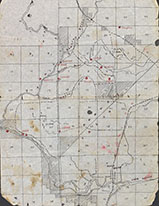
On a hunting trip in "The Bear," in Yoknapatawpha's Big Woods, Ike McCaslin discovers the scriptural truth that one has to get lost in order to find oneself, but that's an exceptional moment in Faulkner's fiction. More representative is what happens at end of The Sound and the Fury, when Luster fails to follow the correct route to the cemetery, and Benjy Compson is plunged into horrifying chaos. Faulkner's Civil War novel, The Unvanquished, begins with a wonderful scene in which two southern boys, one white and one black, create a "living map" of the battle for Vicksburg in the earth of the Sartoris place. At the historical moment when the Confederacy is about to lose its last stronghold on the Mississippi River, and so make inexorable the ultimate loss of the southern world that Ringo and Bayard have always known, the boys try to create "a shield between ourselves and reality, between us and fact and doom." Map-making turns out to be a form of resistance, against getting – or being – "lost."
Citing this source:
Stephen Railton and Christopher Rieger, "Faulkner Mapping|Mapping Faulkner," Digital Yoknapatawpha, University of Virginia, http://faulkner.iath.virginia.edu (date added to project: 2017)
SOURCES: Joseph Blotner, Faulkner: A Biography, 2 volumes (Random House, 1974); Malcolm Cowley, The Faulkner-Cowley File: Letters and Memories, 1944-1962 (Viking Press, 1966); Gabriele Gutting, Yoknapatawpha: The Function of Geographical and Historical Facts in William Faulkner's Fictional Picture of the Deep South (Peter Lang, 1992); Robert W. Hamblin, "'Longer than Anything': Faulkner's 'Grand Design' in Absalom, Absalom!," in Faulkner and the Artist, edited by Donald M. Kartiganer and Ann J. Abadie (University Press of Mississippi, 1966, pp. 369-93); Elizabeth Duvert, "Faulkner's Map of Time," The Faulkner Journal, Fall 1986, pp. 14-28; Don H. Doyle, Faulkner's County: The Historical Roots of Yoknapatawpha (University of North Carolina Press, 2001); Pamela Dalziel, "Absalom, Absalom!: The Extension of Dialogic Form," Mississippi Quarterly (Summer 1992), pp. 277-94; Thomas McHaney, Introduction to The Wild Palms: Publisher's Front Matter and Typescript Setting Copy (Garland, 1986), p. 393; Gabriele Gutting, "The Mysteries of the Map-Maker: Faulkner, If I Forget Thee, Jerusalem, and the Secret of a Map," Faulkner Journal (Spring 1993), pp. 85-89;
|


